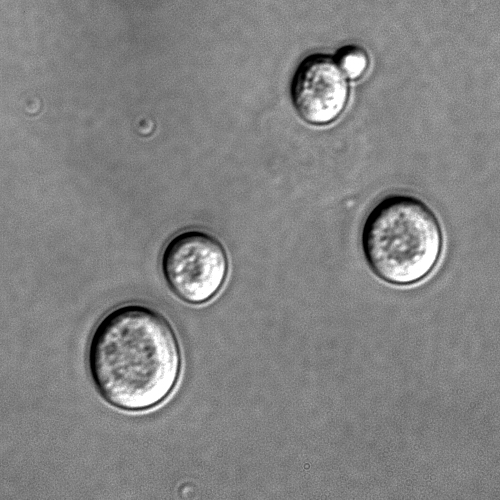Saccharomyces cerevisiae
| Saccharomyces cerevisiae | ||||||||||||||||
|---|---|---|---|---|---|---|---|---|---|---|---|---|---|---|---|---|
 | ||||||||||||||||
| Scientific classification | ||||||||||||||||
| ||||||||||||||||
| Binomial name | ||||||||||||||||
| Saccharomyces cerevisiae Meyen ex E.C. Hansen |
Saccharomyces cerevisiae is a species of budding yeast. It is perhaps the most useful yeast owing to its use since ancient times in baking and brewing. It is believed that it was originally isolated from the skins of grapes (one can see the yeast as a component of the thin white film on the skins of some dark-colored fruits such as plums; it exists among the waxes of the cuticle). It is one of the most intensively studied eukaryotic model organisms in molecular and cell biology, much like Escherichia coli as the model prokaryote. It is the microorganism behind the most common type of fermentation. Saccharomyces cerevisiae cells are round to ovoid, 5–10 micrometres in diameter. It reproduces by a division process known as budding.
It is useful in studying the cell cycle because it is easy to culture, but, as a eukaryote, it shares the complex internal cell structure of plants and animals. S. cerevisiae was the first eukaryotic genome that was completely sequenced. The yeast genome database [1] is highly annotated and remains a very important tool for developing basic knowledge about the function and organization of eukaryotic cell genetics and physiology. Another important S. cerevisiae database is maintained by the Munich Information Center for Protein Sequences [2]. The genome is composed of about 13,000,000 base pairs and 6,275 genes, although only about 5,800 of these are believed to be true functional genes. It is estimated that yeast shares about 23% of its genome with that of humans.
"Saccharomyces" derives from Greek, and means "sugar mold". "Cerevisiae" comes from Latin, and means "of beer". Other names for the organism are:
- Brewer's yeast (the apostrophe may be missing or after the s), though other species are also used in brewing
- Ale yeast
- Top-fermenting yeast
- Baker's yeast (the apostrophe may be omitted or placed after the s)
- Budding yeast
This species is also the main source of nutritional yeast and yeast extract.
Life cycle
There are two forms in which yeast cells can survive and grow, haploid and diploid. The haploid cells undergo a simple lifecycle of mitosis and growth, and under conditions of high stress will generally simply die. The diploid cells (the preferential 'form' of yeast) similarly undergo a simple lifecycle of mitosis and growth, but under conditions of stress can undergo sporulation, entering meiosis and producing a variety of haploid spores, which can go on to mate (conjugate), reforming the diploid.
Mating
Yeast has two mating types, a and α, which show primitive aspects of sex differentiation, and are hence of great interest. For more information on the biological importance of these two cell types, where they come from (from a molecular biology point of view), and details of the process of mating type switching, see the main article.
In science
Saccharomyces cerevisiae is a widely used model organism in science, and therefore also one of the most studied (along with E. coli). S. cerevisiae has obtained this important position because of its established use in industry (e.g. beer, bread and wine fermentation, ethanol production). Additionally, yeasts are comparatively similar in structure to human cells, both being eukaryotic, in contrast to the prokaryotes (bacteria and archaea). Many proteins important in human biology were first discovered by studying their homologs in yeast; these proteins include cell cycle proteins, signaling proteins, and protein-processing enzymes. The petite mutation in S. cerevisiae is of particular interest.
Top-fermenting yeast
Saccharomyces cerevisiae is known as a top-fermenting yeast. It is one of the major types of yeast used in the brewing of beer (along with Saccharomyces carlsbergensis and Brettanomyces sp.), so called because during the fermentation process it rises to top of the fermentation vessel. Beers that use top-fermenting yeast are called ales, and for that reason these yeasts are also sometimes called "ale yeast".
Top-fermenting yeasts are unable to ferment some types of sugars, and the resulting beer is sweeter and "fruitier".
Uses in Aquaria
Owing to the high cost of commercial CO2 cylinder systems, CO2 injection by yeast is one of the most popular DIY approaches followed by aquaculturists for providing CO2 to underwater aquatic plants. The yeast culture is generally maintained in plastic bottles and typical systems provide one bubble every 3-7 seconds. Various approaches have been devised to allow proper absorption of the gas into the water.
See also
References
External links
| Wikimedia Commons has media related to Saccharomyces cerevisiae. |
- Saccharomyces Genome Database
- Cell cycle and metabolic cycle regulated transcription in yeast
- Yeast Resource Center Public Data Repository
- Munich Information Center for Protein Sequences - abstract of the paper describing the genome
- What are Yeast
- BioPIXIE
- BioGRID: A General Repository for Saccharomyces cerevisiae Interactions
CO2 injection by Yeast for Planted Aquaria
an:Saccharomyces cerevisiae bg:Дрожди cs:Saccharomyces cerevisiae de:Obergärige Hefe et:Pinnakääritamine it:Saccharomyces cerevisiae hu:Élesztőgomba sk:Kvasinka pivná fi:Hiiva sv:Saccharomyces cerevisiae